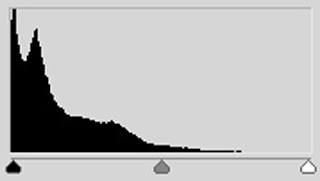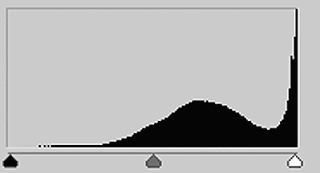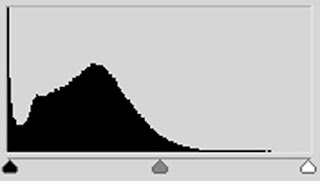2.1/30
3.f/11
4.ISO100
5.1/1000
Midterm Exam
1. Your camera tells you that 1/125 @ F11 is the correct exposure. List two other exposures that would allow you to bracket around this reading.
f8, 1/125 ; f/16, 1/125
2. Fill in the intermittent apertures.
f2.8, f4, f5.6, f8, f11, f16, f22
3. Fill in the intermittent shutter speeds.
1/2, 1/4, 1/8, 1/15, 1/30, 1/60, 1/125, 1/500
4. F22 would produce a shallower depth of field than F8. True
5. While photographing a scene, the camera shows that 1/250 @ F16 will produce a correct exposure. Give two equivalent exposures for this reading.
f/11, 1/500; f/22, 1/125
6. Which shutter speed would best stop a car moving across the frame.
A) 1/1000 sec B) 1/30 sec C) 1/4000 sec D) 1/60 sec
1/4000 sec
7. Dodging is the global adjustment that will darken areas of your image. False
8. An ISO rating of 400 is more sensitive to light than 800. False
9. What is the difference between global and local adjustments?
The global adjustment is where your main enhancements to your Adaptive Exposure, Details, Color and Noise occur. The Local adjustments means your adjustments here are not applied to your entire image, and instead are only applied "locally" to the section of the image that you select.
10. How many mega pixels you need to make a 8x12 print at 360 ppi? 12 megapixels
11. Name two tools in Photoshop you can use to adjust the density (brightness) of your image.
Brightness/Contrast , Dodge
12. Name three tools you can use in Photoshop to change the color of your image.
Hue/Saturation, Curves, Color Balance
13. What is the best file type to use when emailing or posting pictures to the web? JEPG
14. What is the advantage of using adjustment layers?
The adjustment layers are a group of a super useful, non-destructive image editing tools that add color and tonal adjustments to images without permanently changing its pixels.
15. What color workspace is best used when editing photographs? Adobe RGB
16. Histograms is a graphic representation of your image and can also be used to judge for correct exposure.
17. Name two tools in Camera Raw you can use to change the density of your image.
Tone Curve, Sharpening
18. Name two tools in Camera Raw you can use to change the color of your image.
Temperature Adjustment, Tint Adjustment
19. What is exposing to the right and what is its advantage.
Exposing to the right, or ETTR, is an approach to photography that is as helpful as it is controversial. On one hand, exposing to the right is yet another technique to remember while shooting, and it can potentially ruin your exposure if utilized incorrectly. On the other hand, at least in theory, ETTR is the epitome of digital exposure. With proper ETTR, your images have as much detail in the shadows as they possibly can, without any of the highlights losing information along the way.
20.Draw a basic histogram for an underexposed image.

21.Draw a basic histogram for an overexposed image.

22.Draw a basic histogram for a correctly exposed image.

24. Name two advantages of having a larger digital sensor.
a. Larger sensors generally provide high resolution.
b. Larger sensors result in improved low-light performance.
c. Dynamic range will likely be increased with larger image sensors.
d. A larger sensor lets you create more background blur.
e. A larger sensor can mean less diffraction.
f. Larger sensors reduce the crop factor.
25. Pixels of unrelated color and/or brightness to surrounding pixels are known as Noise.
26. Name two factors that would cause noise.
Resizing an image without converting it to smart object.
Sharpening an image in Photoshop too much.
27. In camera raw what is the difference between the Vibrance controls and the Saturation controls.
Saturation change the intensity of colors and can result in loss of detail, while Vibrance increase the intensity of the more muted colors and leaves the already well-saturated colors alone.
28. Images made of pixels are known as vector based images. False
29. Name two tools you can use to retouch a photograph.
Healing Bush Tool, Patch Tool.
30. Name three tools you can use to make a selection.
Lasso Tool, Magic Wand Tool, Marquee Tool
31. Name two tools in Camera Raw can you use to adjust a particular area of an image.
Shadows, Highlight
32. When editing an image what does the term “clipping” mean. i.e. highlight clipping.
Clipping is a result of capturing or processing an image where the intensity in a certain area falls outside the minimum and maximum intensity which can be represented. It is an instance of signal clipping in the image domain.
33. Name two advantages to shooting with a raw file.
Take full advantage of dynamic range.
Correct lens imperfections.
34. What software is best used to get the images from your camera onto your computer?
Adobe Bridge
35. What is the best way to erase areas in an image?
By using masking, you don't damage the original file and can undo when you want the erased area back.
36. Name two controls in Camera Raw used to recover image detail.
Exposure and Clarity
Bonus
1. What year was the first digital camera produced?
It was created in December 1975 by an engineer at Eastman Kodak named Steve Sasson, now regarded as the inventor of the digital camera.
Bonus
1. What year was the first digital camera produced?
It was created in December 1975 by an engineer at Eastman Kodak named Steve Sasson, now regarded as the inventor of the digital camera.
2. What is the temperature scale used to measure color temperature in photography?
Kelvin
3. What president is on the $100 bill?
Benjamin Franklin is on the $100 dollar bill, but he was not a president.